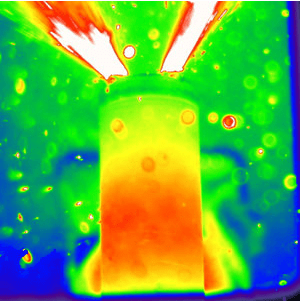Lithium-Ion Batteries Studied During Thermal Runaway Using 3D Imaging
Lithium-ion (Li-ion) batteries are well-known type of rechargeable batteries, which are commonly used for powering consumer electronics such as mobile phones, laptops, et al. However, they can be hazardous under some conditions and can also put the safety of the users in danger. In order to study this issue, the researchers from University College London (UCL), European Synchrotron Radiation Facility (ESRF), Imperial College London (ICL) and the National Physical Laboratory used sophisticated 3D imaging for tracking the lithium-ion batteries when they overheat and explode. The study that demonstrated how damages are caused to the batteries internally and later spread to adjacent batteries in real time was published in the Nature Communications journal.

Earlier, for analyzing the failure process of the battery X-ray computed tomography (CT) was used. X-ray CT was also used for monitoring the changes under normal operating conditions. But in this research, for mapping and tracking the changes to the internal structure and external temperature of the Li-ion batteries in real time, the team integrated synchrotron X-rays having high energy with thermal imaging. This helped the scientists to study two types of Li-ion batteries when exposed to intense heat having temperature of 250+ degrees Celsius. At the time of thermal runaway (a process when a battery overheats and often leads to a destructive result), 3D images can be taken in fractions of a second due to strong photon flux and high speed imaging detector.
The researchers studied the effects of gas pockets forming, venting and increasing temperatures on the layers of both the batteries. The battery with an internal support was not damaged until thermal runaway. At about 1000 degrees Celsius, the copper substance of the cell melted. Whereas in case of the battery without internal support, exploded and the cap of the battery was separated. This explosion caused the ejection of the materials. Before thermal runaway, the nearby objects were damaged due to the collapse of the core. Dr Paul Shearing (UCL Chemical Engineering) mentioned in a statement that their method of tracking battery damage in 3D and in real-time can help to understand how battery failure initiates and spreads and will also aid in designing batteries with improved safety features.
The team further wants to study large-sized batteries and investigate what changes at a microscopic level cause battery failure.
Source: #-Link-Snipped-#
Earlier, for analyzing the failure process of the battery X-ray computed tomography (CT) was used. X-ray CT was also used for monitoring the changes under normal operating conditions. But in this research, for mapping and tracking the changes to the internal structure and external temperature of the Li-ion batteries in real time, the team integrated synchrotron X-rays having high energy with thermal imaging. This helped the scientists to study two types of Li-ion batteries when exposed to intense heat having temperature of 250+ degrees Celsius. At the time of thermal runaway (a process when a battery overheats and often leads to a destructive result), 3D images can be taken in fractions of a second due to strong photon flux and high speed imaging detector.
The researchers studied the effects of gas pockets forming, venting and increasing temperatures on the layers of both the batteries. The battery with an internal support was not damaged until thermal runaway. At about 1000 degrees Celsius, the copper substance of the cell melted. Whereas in case of the battery without internal support, exploded and the cap of the battery was separated. This explosion caused the ejection of the materials. Before thermal runaway, the nearby objects were damaged due to the collapse of the core. Dr Paul Shearing (UCL Chemical Engineering) mentioned in a statement that their method of tracking battery damage in 3D and in real-time can help to understand how battery failure initiates and spreads and will also aid in designing batteries with improved safety features.
The team further wants to study large-sized batteries and investigate what changes at a microscopic level cause battery failure.
Source: #-Link-Snipped-#
Replies
You are reading an archived discussion.
Related Posts
(Posted by Hari Kothale on FB)
https://www.facebook.com/groups/225333157489274/permalink/908276002528316/
Download 'Visual Studio Code' - a free code editor that works on Apple OSX (yep!), uBuntu (yep!) and of course, Windows operating systems - from official Microsoft website: here. You...
Alcatel One Touch is known for offering high quality and low-cost products to T-Mobile customers. This time, they have teamed up with the American cellular service provider to take the...
What might seem to have come straight out of a sci-fi movie, the new research work done by the South Korean Pusan National University team may leave you spellbound. Imagine...
PLEASE LET ME KNOW THE FORMULAS/PROCESS DETAILS ON CALCULATING THE WIND LOAD ON METALLIC FENCE
